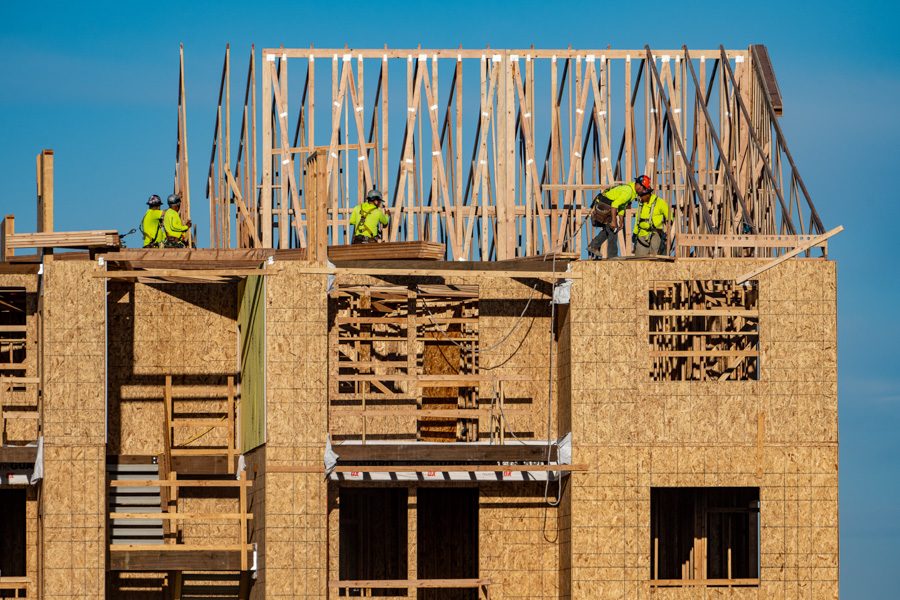
Home » Eased restrictions create multifamily housing boom
City of Pasco
Eased restrictions create multifamily housing boom

October 14, 2024
Pasco recently made a major change to its residential zoning, and the city is seeing immediate benefits when it comes to housing availability, housing diversity and housing prices.
“There’s roughly 5,700 housing units that have either been recently built, in some sort of pre-development phase, going through the review process or under construction in Pasco,” said Jacob Gonzalez, director of Community & Economic Development for the city of Pasco.
The change, related to the density allowed in certain areas, opened the door for multifamily housing and accessory dwelling units, also known as “mother-in-law units.” A short time ago, the city had fewer than 100 townhomes and now has 1,000 finished or about to start – just in the last six to eight months.
“The city was fairly restrictive in housing types prior to the changes; roughly 80% of our zoning allowed one type of housing unit, and so that’s what we got,” Gonzalez said. “Pasco was like other mid-cities across the country, just extremely off balance. And now we’re seeing mixed-housing developments: townhomes and single-family detached in the same development, plus duplexes and single-family detached lots in the same development. That’s something we haven’t seen in a couple of generations.”
An underbuild
Adding any type of housing, and especially multifamily housing, helps chip away at what the Tri-Cities Home Builders Association calls an “underbuild,” which is not enough housing to meet the demand of a growing community, leaving the market unbalanced.
“Our underbuild is just under a thousand homes, and while that doesn’t sound bad, what it means is we’ve got an inventory of existing and new homes that doesn’t give us a healthy mix of a supply,” said Jeff Losey, executive director of HBA Tri-Cities.
Following approval by Pasco City Council, Gonzalez said the available housing types, once mainly single-family detached, were flipped to now offer 80% of other types, especially multifamily, leading to massive growth and multistory complexes, many visible along Burns Road, on the westernmost side of the city. A permit issued for just one of those projects includes 300,000 square feet of building space across nine buildings, consisting of 24 to 30 units with a clubhouse, garages and pool – valued at $41 million.
A Washington law focused on increasing residential building capacity and offering grant assistance for doing so says: “The goal of any such housing plan must be to encourage construction of additional affordable and market rate housing in a greater variety of housing types and at prices that are accessible to a greater variety of incomes, including strategies aimed at the for-profit single-family home market.”
Losey said builders have gotten more creative with the ease in restrictions by doing more with less.
“You can better utilize the dirt to get more families in one space, whereas before it might have been going before the planning commission and city council to have an ordinance change to move to multifamily. Now, those things can happen quicker, which means housing can be built quicker,” he said.
Pasco city leaders adopted the Housing Action and Implementation Plan in late 2023, and Gonzalez said the results are apparent. “Now you’re seeing more options spread out evenly throughout the city versus being concentrated in one area,” he said. “We’re seeing infill developments in central, west and east Pasco.”

The Pasco Specialty Kitchen is a certified commercial kitchen in downtown Pasco that’s been helping food entrepreneurs grow their businesses since 2003.
| Photo by Nathan FinkeThe increased supply is working to fill the constant demand, with these added options pushing it more toward a buyer’s market. Economic leaders say that by creating enough housing, the older units become more affordable, creating a balance on pricing.
“We’re starting to see selling prices we haven’t seen since pre-Covid,” Gonzalez said. “It’s proof that if you remove restrictions, you will start to see a slowdown in the rapid rise of prices. More housing opportunities have become a shining star for Pasco.”
By “taking some of the pressure off the dirt,” Losey said the market could become more equalized, though he still sees most “starter” homes around $400,000.
“With being short on inventory, and interest rates coming down, this pent-up demand is still there,” Losey said. “With the changes in Pasco, it allows more opportunity for infill, because it is hard to get dirt to develop on. It’s helped builders go from a single-family residence to a two- or four-plex, which helps lessen the demand on housing.”
Pasco boasted the most single-family home permits issued throughout the bicounty region, with 251 permits issued and valued at more than $79 million through August 2024. That’s 57% more than the same period the previous year.
The state’s 16th largest city – frequently named as an area of rapid growth both on a regional and national level – is preparing to gain 50,000 more residents in the next quarter-century, adding onto Pasco’s current population of more than 82,000, according to the most recent state data.
Traffic woes
Gonzalez expects as more housing units come online and become occupied in the next six to nine months, there will be a dramatic increase in the city’s population – and potentially the traffic, which is already a burden, and one the city’s public works department is constantly trying to improve.
The interchange at Interstate 182 and Broadmoor Boulevard that added an additional freeway offramp and roundabout is expected to wrap up toward the end of the year. The public investment in infrastructure will spur additional private development and keep the city “a business-friendly format so that when somebody is ready to invest and locate in Pasco, we’ll be ready for them,” Gonzalez said.
The city also has begun work on adding a roundabout to the intersection of North Road 68 and West Court Street, south of the interstate and currently served with a two-way stop.
“That’s more of a safety project, but it would be a pretty significant improvement with the roundabout there,” Gonzalez said. Safety improvements also are coming to Sylvester Street, on either side of the blue bridge, adding pedestrian and bike access.
“I think it is really going to transform that entire stretch of the city,” he said. “It’s a pretty significant project that covers multiple miles and will enhance the usability of the corridor without taking away from vehicles.”
Industrial projects
Pasco’s appetite for housing options is also connected to several large industrial projects within the city, including three Amazon distribution centers. Gonzalez said these projects are really changing the landscape, especially along Interstate 395 on the north end of the city, diversifying the industrial sector.
“You’ve got Darigold doing something that doesn’t really happen elsewhere,” Gonzalez said. “North America’s largest whey processing plant being charged right now in Pasco, along with the distribution center expansions with Amazon, are pretty significant and we’ve been fortunate to be able to tie both down.”
Gonzalez said Amazon is still getting ramped up and the number of people hired is only a small percentage of what it is likely to be when the distribution centers are fully operational.
“For industrial users, warehousing and freight based in Pasco, this is significant,” Gonzalez said. This brings the issue back to housing and the need for more options to serve this growing commercial and industrial base.
“You don’t have to drive too far or walk too far without seeing new development for housing across the city and the diversity of housing; it’s critically important,” Gonzalez said. “The housing crisis is something that’s been talked about over and over.”
“All the jobs that are being created through Amazon, through Darigold and through those other opportunities, people start looking for places to live,” Losey said.

Saul Martinez opened Café con Arte, a coffee shop-art gallery, in January 2024 at 430 W. Columbia St. in downtown Pasco.
| Photo by Robin WojtanikDowntown core
The city is proud of the development that’s gone on in its downtown core, with the addition of popular restaurants like Ciao Trattoria and its sister property, Imbibe, along with Café con Arte coffee shop, and other spots incubating in the city-run commercial kitchen at 110 S. Fourth Ave., now home to Mami’s Spicy Ceviche. It credits these additions and word-of-mouth with an increased number of visitors to the downtown, anchored by the Pasco Farmers Market and city-funded improvements there, along with Peanuts Park.
“I think being able to use those as a kind of catalyst for continued private and public investment downtown is going to continue,” Gonzalez said. “It’s great to see that effort and the reaction of the investment from public and private folks as stakeholders. The community is our downtown.”
The city also is excited about what’s on the horizon with Osprey Pointe, a project that’s faced long delays in getting off the ground. The eventual vision is for 55 acres of homes – both single family and multifamily – commercial opportunities and a marketplace. The owners of Ciao Trattoria and Imbibe have shared their intentions of opening a restaurant there when the massive project finally gets off the ground.
Gonzalez said a recent zoning change will support development plans.
“It’s kind of the next step and allows them to move forward with their master plan with residential and retail commercial space,” Gonzalez said. “I think there’s a lot of excitement both inside and outside of City Hall. That’s the kind of development that could dramatically improve a region.”
The city is keenly aware that it’s a long timeline from the time a story breaks on a building permit being issued – to the time a business is actually up and running, and this is all the more apparent for some of these massive projects locating in Pasco, including Osprey Pointe, Amazon and Darigold.
All this future growth is driving Pasco leaders to keep their eyes on the prize: meet the demand on housing for those looking to move to Pasco, whether from a commercial or residential perspective.
“There are all sorts of terms, ‘affordable,’ ’attainable,’ and they’re all buzzwords,” Gonzalez said. “The reality is we’ve got to get a lot of housing available for people. We’ve got new industries coming into town and across the region, and the Tri-Cities kind of operates as one market, of course. So, being able to provide the necessary housing is critical for us to ensure our residents have access to a safe place to sleep at night.”
Construction + Real Estate
KEYWORDS October 2024





